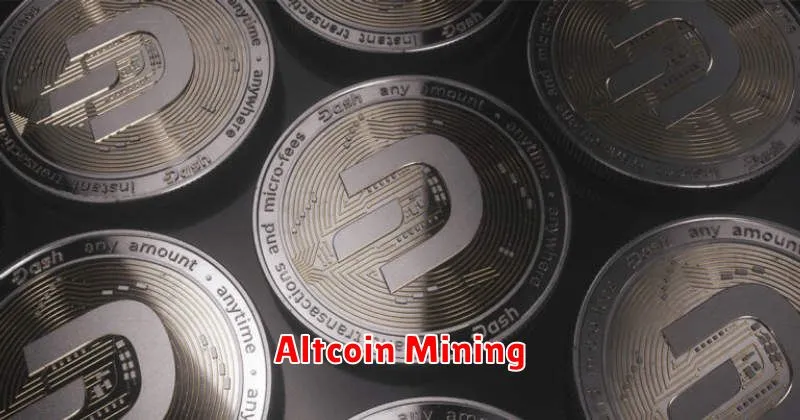This comprehensive guide will walk you through the process of altcoin mining, a potentially lucrative but complex endeavor. We’ll cover everything from choosing the right altcoin to mine, understanding mining hardware requirements, selecting a suitable mining pool, and optimizing your mining rig for maximum efficiency and profitability. Whether you’re a seasoned cryptocurrency investor or a curious newcomer, learn how to navigate the world of altcoin mining and unlock its possibilities. This step-by-step guide ensures you’re equipped with the knowledge to make informed decisions and successfully embark on your altcoin mining journey.
What Are Altcoins?

Altcoins are alternative cryptocurrencies to Bitcoin. They are digital or virtual currencies that utilize blockchain technology, similar to Bitcoin, but with different functionalities, features, and underlying technologies. Each altcoin has its own unique characteristics, such as varying consensus mechanisms (e.g., Proof-of-Work, Proof-of-Stake), transaction speeds, and overall goals.
Examples of popular altcoins include Ethereum, Litecoin, and Ripple. They are often created to address perceived limitations of Bitcoin or to introduce innovative applications within the blockchain space. While some altcoins aim to improve upon Bitcoin’s technology, others focus on specific use cases, such as decentralized finance (DeFi) or non-fungible tokens (NFTs).
Understanding the differences between altcoins and Bitcoin is crucial before mining them. Each altcoin requires specific mining hardware and software, and the profitability of mining varies significantly based on the coin’s value, difficulty, and energy consumption.
How Altcoin Mining Differs from Bitcoin Mining
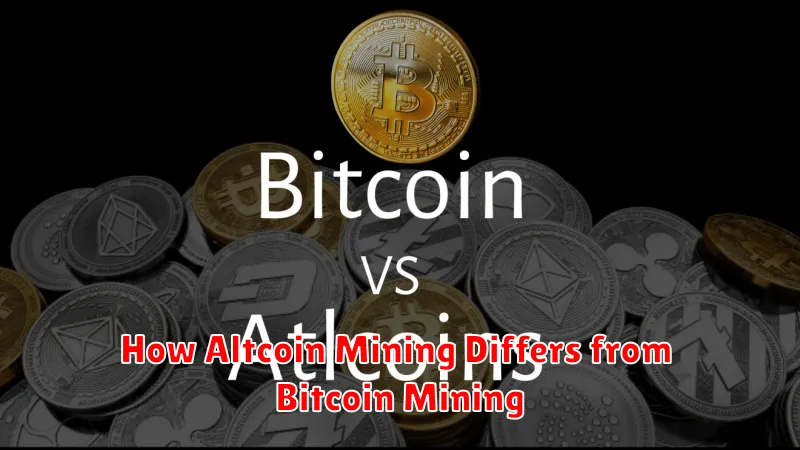
While both altcoin and Bitcoin mining involve solving complex cryptographic puzzles to validate transactions and add new blocks to the blockchain, several key differences exist. Bitcoin mining utilizes the SHA-256 algorithm, whereas altcoins employ various algorithms, including Scrypt, X11, and Ethash, among others. This algorithm variation impacts the type of hardware best suited for mining.
Difficulty levels also differ significantly. Bitcoin’s vast network and high hash rate result in a much higher difficulty than most altcoins. This means that mining Bitcoin requires significantly more computational power and energy, making it less profitable for individuals unless they possess substantial resources. Altcoins, with their generally lower difficulty, present a more accessible entry point for individual miners with less powerful hardware.
The reward mechanisms vary as well. Bitcoin’s block reward halves periodically, decreasing the amount of Bitcoin rewarded for mining a block. Altcoins have their own unique block reward schedules and may have different total coin supplies, potentially impacting profitability and long-term value.
Finally, the market capitalization and overall popularity of the cryptocurrency significantly impact mining profitability. Bitcoin’s dominance often means that mining it, despite its difficulty, can yield higher returns than mining less popular altcoins, even if those altcoins have lower difficulty levels. The price volatility of both Bitcoin and altcoins further complicates profit calculations.
Best GPUs for Altcoin Mining
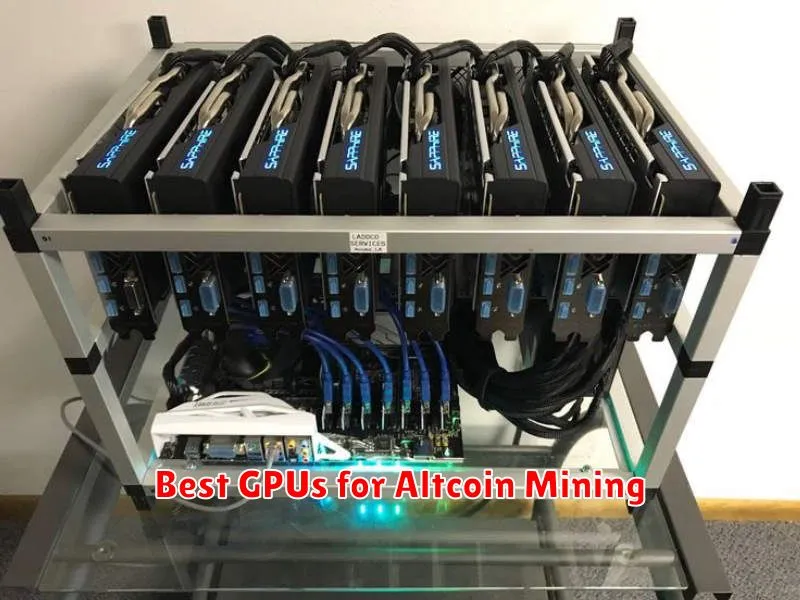
Choosing the right GPU is crucial for efficient altcoin mining. Performance depends on factors like hash rate, power consumption, and memory. While specific models fluctuate in price and availability, certain brands and architectures consistently deliver strong results.
Nvidia cards, particularly those based on the Ampere and Ada Lovelace architectures (e.g., RTX 30 series and RTX 40 series), often top the charts for many altcoin mining algorithms. Their high memory bandwidth and processing power are well-suited to the task.
AMD GPUs, especially those with high VRAM (e.g., RX 6000 series), are also competitive, sometimes offering a better price-to-performance ratio. However, performance can vary significantly depending on the specific altcoin and mining algorithm.
Ultimately, the best GPU for you will depend on your budget, the specific altcoin you intend to mine, and the algorithm it uses. Researching the current performance benchmarks for your target altcoin is highly recommended before making a purchase. Consider factors like hash rate, power consumption, and memory capacity when comparing different models.
Top Altcoins to Mine in 2025
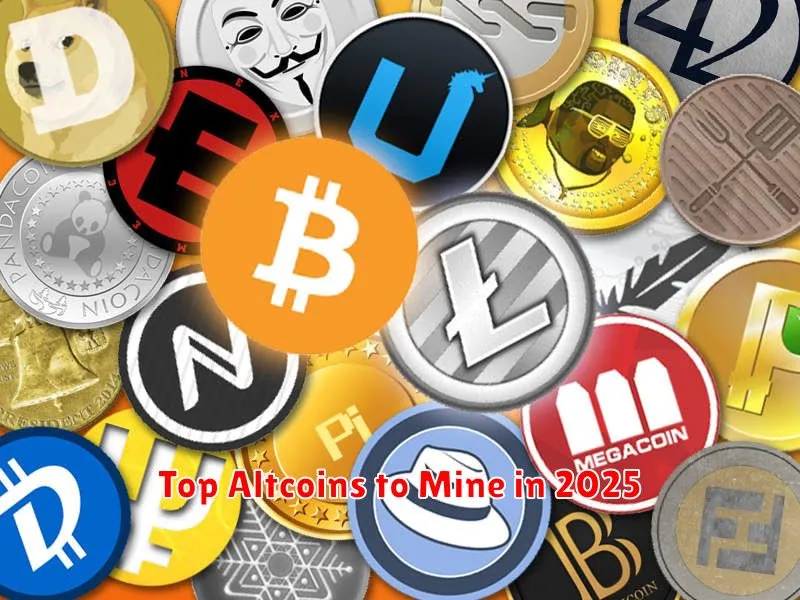
Predicting the most profitable altcoins to mine in 2025 is inherently speculative, as cryptocurrency markets are highly volatile. However, several factors can influence profitability, including algorithm, hardware requirements, and network difficulty. Focusing on coins with proven technology and strong community support is crucial.
Potential candidates for profitable mining in 2025 may include coins utilizing energy-efficient algorithms like those employing Proof-of-Stake (PoS) or newer consensus mechanisms. Coins with relatively low network difficulty at the time could also offer better returns. It’s important to perform thorough research on each coin’s mining specifics, considering factors like block rewards, transaction fees, and hardware costs. Remember to factor in electricity costs, as these significantly impact profitability.
Ultimately, the best altcoin to mine will depend on your specific hardware, electricity costs, and risk tolerance. Continuous monitoring of market trends and technological advancements is essential for adapting your mining strategy and maximizing potential returns. Always consider diversification to mitigate risks associated with individual coin performance.
Using Cloud Mining for Altcoins

Cloud mining offers a convenient alternative to setting up your own altcoin mining operation. Instead of investing in and maintaining expensive hardware, you rent hashing power from a cloud mining provider.
Choosing a reputable provider is crucial. Research thoroughly, considering factors like contract terms, hashing power offered, and the provider’s track record. Beware of scams promising unrealistic returns.
The process typically involves creating an account, selecting a mining plan (often based on contract length and hashing power), and making a payment. You then receive a dashboard to monitor your mining progress and payouts. Payouts are usually in the chosen altcoin.
While cloud mining eliminates the need for hardware management, it’s important to be aware of potential downsides. These include dependence on the provider’s reliability and potential for higher costs compared to self-mining if electricity prices are low. Profitability is also dependent on the altcoin’s price and mining difficulty.
Due diligence is essential before committing to a cloud mining contract. Understand the associated fees, contract terms, and the provider’s reputation to mitigate risks and maximize potential returns. Carefully evaluate the profitability based on current market conditions.
How to Join an Altcoin Mining Pool
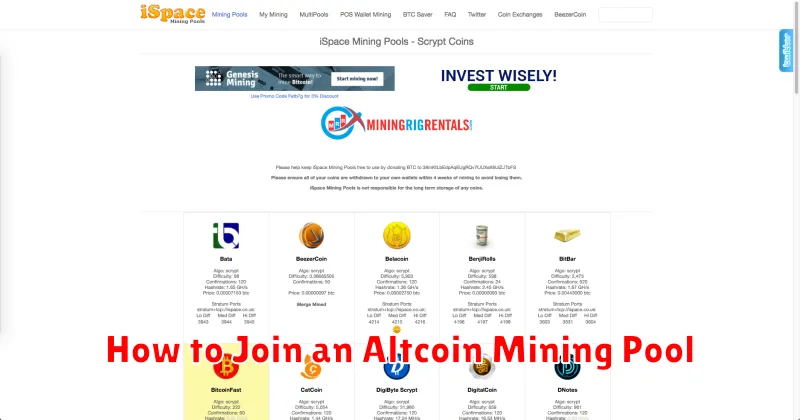
Joining an altcoin mining pool significantly increases your chances of successfully mining altcoins. Instead of competing individually against potentially thousands of miners, you pool your computing power with others, sharing the rewards proportionally based on your contribution.
The process typically involves these steps:
- Choose a Pool: Research reputable pools considering factors like payout frequency, fees, and miner software support. Popular choices include mining pools that support the specific altcoin you wish to mine.
- Download Mining Software: Select mining software compatible with your hardware and the chosen pool. Common options include CGMiner, BFGMiner, or pool-specific software.
- Configure Your Miner: Input your pool’s details (server address and port) into the mining software. You may also need your wallet address to receive your earnings.
- Start Mining: Once configured, start your mining software. Your contribution to the pool will begin, and you’ll start earning a share of the mined altcoins.
- Monitor Your Earnings: Regularly check your account on the mining pool’s website to monitor your hashrate contribution and accumulated rewards.
Remember to carefully review each pool’s terms and conditions and understand their fee structures before joining. Successful altcoin mining relies on consistent hashing power and choosing a reliable pool.
Is Altcoin Mining Still Profitable?
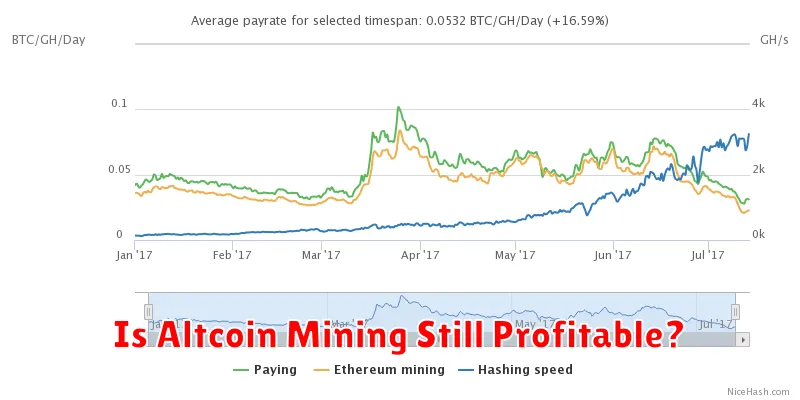
The profitability of altcoin mining is highly variable and depends on several crucial factors. These include the current price of the altcoin, the difficulty of the mining algorithm, the cost of electricity, and the hashrate of your mining hardware.
While some altcoins might offer lucrative returns under favorable conditions, others may yield minimal profits or even losses. The fluctuating nature of cryptocurrency markets makes it difficult to guarantee consistent profitability. Thorough research into the specific altcoin, mining hardware costs, and electricity prices is essential before investing in altcoin mining.
Furthermore, the competitive landscape of altcoin mining is intense. Large mining operations with significant hashrates often dominate, making it challenging for individuals or small operations to compete effectively and generate substantial profits. Careful consideration of these factors is crucial in determining the potential profitability of any altcoin mining venture.

